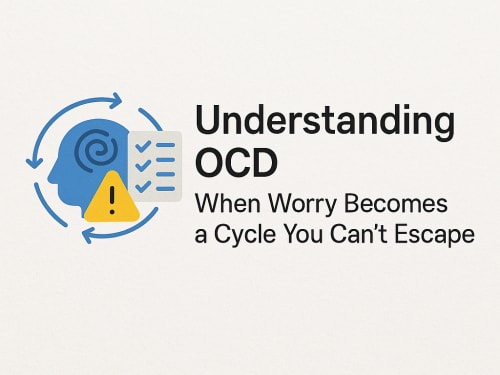🧠 Understanding OCD: When Worry Becomes a Cycle You Can’t Escape

posted 23rd October 2025

🧠 Understanding OCD: When Worry Becomes a Cycle You Can’t Escape
We all double-check things sometimes, making sure the door’s locked, or rereading a text before hitting send. But for people with Obsessive-Compulsive Disorder (OCD), those thoughts and behaviours can spiral into something much more consuming.
OCD isn’t just about being neat or organised (a common misconception!). It’s a mental health condition where unwanted thoughts and repetitive behaviours form a cycle that’s hard to break.
🔄 What Exactly Is OCD?
According to the DSM-5, Obsessive-Compulsive Disorder is defined by two main components:
- 💭 Obsessions – persistent, intrusive thoughts, images, or urges that cause anxiety—for example, fears of contamination, harm, or making a mistake.
- ⚙️ Compulsions – repetitive behaviours or mental acts someone feels driven to perform to reduce the anxiety caused by obsessions. This might include excessive cleaning, checking, counting, or silently repeating phrases.
The relief from performing compulsions is only temporary; soon after, the obsessions return, trapping the person in a cycle of anxiety and repetition.
🌀 Common Myths About OCD
Let’s clear something up: OCD isn’t just about liking things tidy or colour-coded.
People often joke, “I’m so OCD,” when they like order — but real OCD goes much deeper. It’s about anxiety, control, and fear, not preference.
Someone with OCD might know their fears are unrealistic, but still feel powerless to stop the rituals that ease the anxiety, at least for a moment.
⚖️ The Psychology Behind It
Psychologists describe OCD as a maladaptive coping mechanism for anxiety. The brain misinterprets harmless thoughts as dangerous or significant, triggering a fight-or-flight response.
Research links OCD to overactivity in certain brain regions (like the orbitofrontal cortex and caudate nucleus) and an imbalance in serotonin levels, which affect mood and impulse control.
Cognitive theories (e.g., Salkovskis, 1985) also suggest that people with OCD overestimate threats, believe their thoughts are dangerous, and feel an inflated sense of responsibility to prevent harm.
💬 What OCD Can Look Like in Everyday Life
OCD shows up in many forms — it’s not the same for everyone. Some common themes include:
- 🧼 Contamination fears (e.g., excessive washing, avoiding public spaces)
- 🔐 Checking (e.g., repeatedly making sure doors, appliances, or locks are secure)
- ✏️ Perfectionism and order (e.g., arranging or counting until something “feels right”)
- 💭 Intrusive thoughts (e.g., unwanted violent, sexual, or blasphemous thoughts — often misinterpreted as intentional)

💪 How OCD Is Treated: What the Science Shows
The good news? OCD is highly treatable, and modern research shows that the right combination of therapy and (sometimes) medication can make a huge difference.
🧠 Cognitive Behavioural Therapy (CBT) with Exposure and Response Prevention (ERP)
The most effective treatment for OCD is CBT, specifically Exposure and Response Prevention (ERP). This approach helps people gradually face their fears while resisting compulsions — retraining the brain to realise that anxiety naturally fades on its own.
Studies show ERP can reduce symptoms by up to 60–80%, making it the gold-standard psychological treatment (Franklin & Foa, 2011; NICE, 2022). For children and teens, family-based CBT is particularly effective (Piacentini et al., 2016), and online ERP programmes are also proving helpful (Wootton, 2016).
🧩 ERP teaches the brain safety through experience — not reassurance.
💊 Medication for OCD
When symptoms are moderate to severe, SSRIs (like sertraline or fluoxetine) can be used alongside therapy to reduce obsessive thoughts and anxiety. These medications help regulate serotonin levels, making it easier to engage with treatment.
Research shows that SSRIs are most effective at higher doses and when used long-term, especially when combined with CBT (Fineberg et al., 2020).
🧠 Medication doesn’t erase OCD — it quiets the noise so therapy can do its work.
🌱 Living with OCD
Living with OCD can feel exhausting, but understanding it is the first step toward breaking the cycle.
It doesn’t define who you are; it’s something you experience, and with the right support, recovery is absolutely possible.
If you recognise some of these symptoms in yourself or someone you care about, reaching out to a GP, therapist, or mental health service can make a huge difference.
🔍 References
Carmi, L., Tendler, A., Bystritsky, A., et al. (2019). Efficacy and safety of deep transcranial magnetic stimulation for obsessive-compulsive disorder: a prospective multicenter randomized double-blind placebo-controlled trial. American Journal of Psychiatry, 176(11), 931–938.
Fineberg, N. A., Hollander, E., Pallanti, S. (2020). Clinical advances in obsessive–compulsive disorder: a position statement. World Psychiatry, 19(3), 336–356.
Franklin, M. E., & Foa, E. B. (2011). Treatment of obsessive-compulsive disorder. Annual Review of Clinical Psychology, 7, 229–243.
National Institute for Health and Care Excellence (NICE). (2022). Obsessive–compulsive disorder and body dysmorphic disorder: treatment (CG31).
Piacentini, J., et al. (2016). Family-based CBT for child and adolescent OCD: 10-year update. Journal of Clinical Child & Adolescent Psychology, 45(4), 447–461.
Veale, D., Miles, S., Smallcombe, N., et al. (2014). Atypical antipsychotic augmentation in SSRI treatment-refractory obsessive–compulsive disorder: a systematic review and meta-analysis. BMC Psychiatry, 14, 317.
Wootton, B. M. (2016). Remote cognitive-behavior therapy for obsessive-compulsive symptoms: a meta-analysis. Clinical Psychology Review, 43, 103–113.



